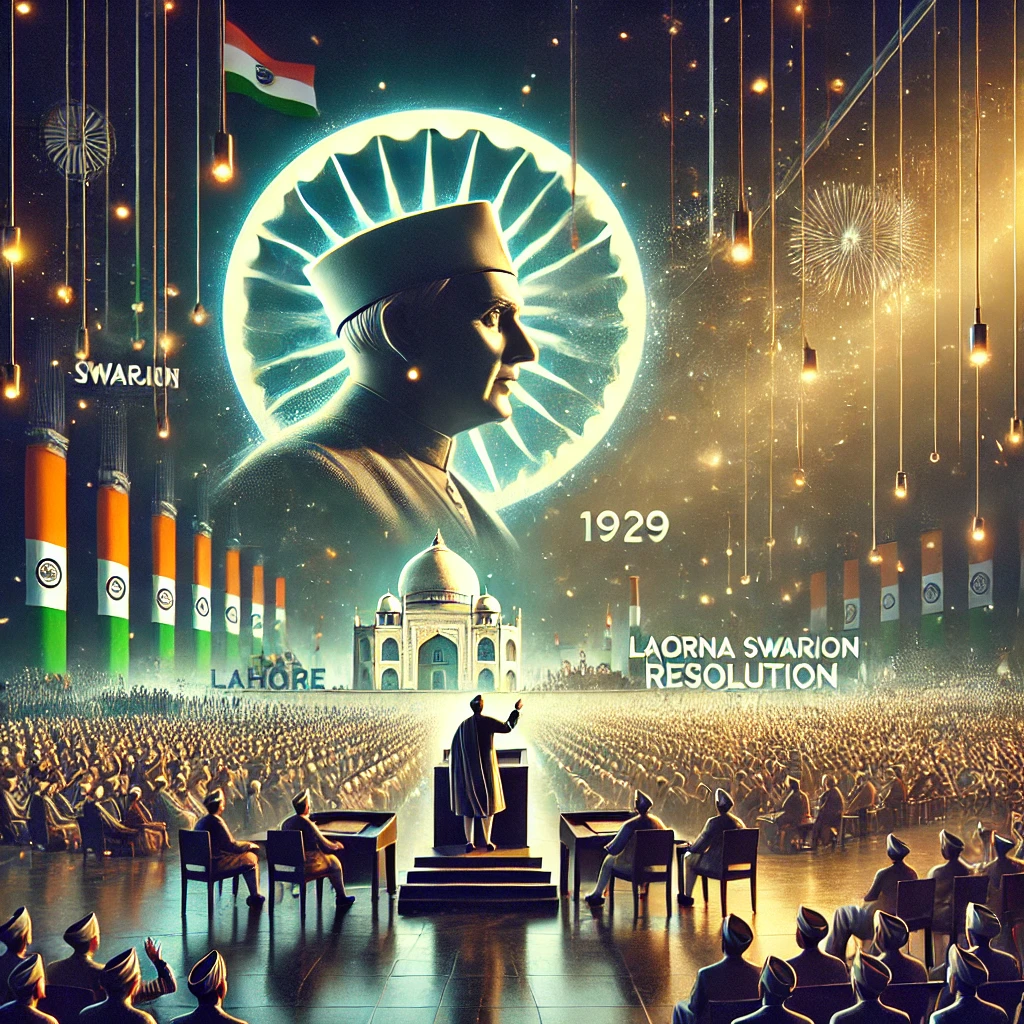The Indian National Congress (INC) played a pivotal role in India’s struggle for independence. Among its many significant sessions, the Lahore Session of 1929 stands out as a turning point in India’s freedom movement. It was in this session that the resolution for ‘Poorna Swaraj’ (Complete Independence) was officially adopted. This marked a shift from the earlier demand for Dominion Status to the outright demand for full independence from British rule.
This article explores the background, proceedings, significance, and impact of the Lahore Session of 1929, which laid the foundation for India’s final push towards independence.
Background: The Need for a Radical Shift
Before 1929, the Congress had mainly advocated for Dominion Status under British rule. This meant that India would remain a part of the British Empire but enjoy self-governance, similar to Canada or Australia. However, several events in the 1920s led to growing dissatisfaction among Indians:
1. The Failure of the Simon Commission (1927)
- The Simon Commission, sent to review India’s constitutional status, had no Indian members, leading to widespread protests.
- The slogan “Simon Go Back” echoed throughout the country, showing India’s rejection of British-imposed reforms.
2. Nehru Report (1928) and British Rejection
- The Nehru Report, led by Motilal Nehru, recommended Dominion Status and constitutional reforms.
- However, the British ignored these demands, fueling frustration among Indian leaders.
3. Rising Influence of Younger Leaders
- Leaders like Jawaharlal Nehru and Subhas Chandra Bose pushed for a more radical approach.
- They argued that Poorna Swaraj (Complete Independence) was the only way forward.
4. Lord Irwin’s Vague Promise (1929)
- Lord Irwin, the British Viceroy, vaguely promised Dominion Status in the future but gave no clear timeline.
- This was seen as a delaying tactic, further angering Indian nationalists.
Given these developments, the Congress decided to take a firm stand for complete independence at its next session.
The Lahore Session of 1929: A Turning Point
When and Where?
- The Lahore Session of the Indian National Congress was held from December 29 to 31, 1929 in Lahore (now in Pakistan).
Who Presided Over the Session?
- The session was presided over by Jawaharlal Nehru, who was just 40 years old at the time.
- His election as President marked a generational shift in Congress leadership.
Major Decisions Taken at the Lahore Session
1. Adoption of the ‘Poorna Swaraj’ Resolution
- The most significant decision of the session was the adoption of Poorna Swaraj (Complete Independence) as the ultimate goal of India’s freedom movement.
- This was a major shift from the earlier demand for Dominion Status.
2. Declaration of January 26, 1930, as Independence Day
- Congress declared January 26, 1930, as Independence Day to be celebrated across the country.
- On this day, people were urged to take a pledge for complete independence.
- Later, after India gained independence, January 26 was chosen as Republic Day in honor of this historic resolution.
3. Launch of Civil Disobedience Movement
- The session laid the groundwork for Mahatma Gandhi’s Civil Disobedience Movement.
- Congress authorized Gandhi to lead a mass movement against British rule.
4. Boycott of British Goods and Institutions
- The resolution also called for a boycott of British goods, institutions, and services.
- Indians were encouraged to promote Swadeshi (indigenous goods) and reject foreign-made products.
5. Condemnation of British Repression
- The Congress strongly criticized British policies, especially police brutality and unjust laws against Indian nationalists.
Significance of the Lahore Session of 1929
1. The First Official Demand for Complete Independence
- For the first time, Congress officially demanded complete independence, breaking away from the idea of Dominion Status.
- This set the course for future struggles, including the Quit India Movement (1942).
2. Emergence of Jawaharlal Nehru as a National Leader
- Nehru’s election as Congress President signified the rise of a new generation of leaders.
- He became the face of India’s radical nationalist movement.
3. The Foundation of Republic Day
- The declaration of January 26, 1930, as Independence Day ultimately led to the selection of January 26, 1950, as Republic Day, when India adopted its Constitution.
4. A United Nationalist Movement
- The session unified different factions within Congress under the common goal of complete independence.
5. Inspired Mass Participation
- The declaration of Poorna Swaraj inspired millions of Indians to join the freedom movement.
- It gave a clear direction to the struggle for independence.
Impact of the Poorna Swaraj Resolution
1. Civil Disobedience Movement (1930-34)
- Following the Lahore Session, Mahatma Gandhi launched the Civil Disobedience Movement in 1930.
- The famous Dandi March (Salt Satyagraha) was part of this movement, defying British salt laws.
2. Increased Repression by the British
- In response to the Poorna Swaraj resolution, the British intensified their crackdown on nationalist leaders.
- Thousands of freedom fighters were arrested for participating in protests.
3. Strengthening of National Unity
- The demand for complete independence united Indians across different regions, religions, and social backgrounds.
- Even moderate leaders accepted that British rule had to end entirely.
4. Led to the Quit India Movement (1942)
- The idea of Poorna Swaraj ultimately led to the Quit India Movement, which directly challenged British rule.
5. Achieved Independence in 1947
- The Lahore Resolution of 1929 paved the way for India’s independence on August 15, 1947.
Conclusion
The Lahore Session of 1929 was a historic milestone in India’s struggle for freedom. By adopting the Poorna Swaraj resolution, the Indian National Congress made a decisive break from the demand for Dominion Status and set the stage for mass civil disobedience.
The session also marked the rise of Nehru as a national leader and led to the eventual celebration of January 26 as Republic Day. The Poorna Swaraj pledge taken by millions of Indians in 1930 became the foundation for India’s final push for independence, which was ultimately achieved in 1947.




